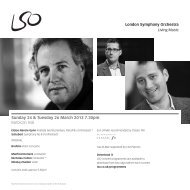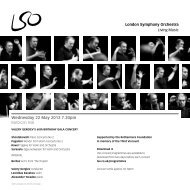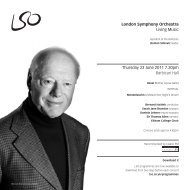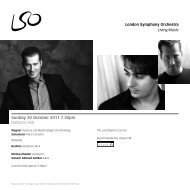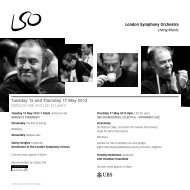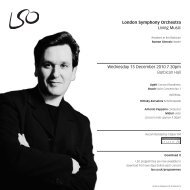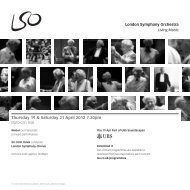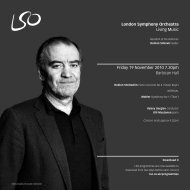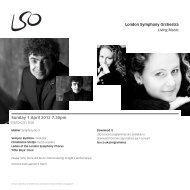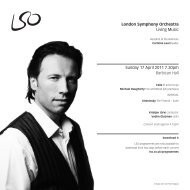Sunday 10 June 2012 - London Symphony Orchestra
Sunday 10 June 2012 - London Symphony Orchestra
Sunday 10 June 2012 - London Symphony Orchestra
Create successful ePaper yourself
Turn your PDF publications into a flip-book with our unique Google optimized e-Paper software.
Wolfgang Amadeus Mozart (1756–91)<br />
Piano Concerto No 20 in D minor, K466 (1785)<br />
1 Allegro<br />
2 Romance<br />
3 Rondo: Allegro assai<br />
Maria João Pires piano<br />
The decade which Mozart spent in Vienna from 1781 until his death<br />
was when he truly found his own voice as a composer, and nowhere<br />
is this new maturity and individuality better shown than in his piano<br />
concertos of the period. Altogether he wrote 17 of them while in the<br />
Imperial capital, mostly for himself to play at the public and private<br />
concerts which helped provide him with financial support, and as such<br />
they were the works with which he was most closely associated by his<br />
audiences. More importantly, it was with them that he established the<br />
piano concerto for the first time as a sophisticated means of personal<br />
expression rather than a vehicle for polite public display.<br />
The high-point in the series came with the five concertos composed<br />
in the period of just over a year from the beginning of 1785. K466 –<br />
completed and first performed in February 1785 – is chronologically<br />
at the head of this group, but musically speaking it also stands out<br />
in many ways. The composer’s father Leopold, visiting Vienna at the<br />
time, heard the premiere, and a little over a year later was organising<br />
a performance by a local pianist back in Salzburg. He later described<br />
the occasion in a letter to his daughter: ‘Marchand played it from<br />
the score, and [Michael, brother of Joseph] Haydn turned over the<br />
pages for him, and at the same time had the pleasure of seeing with<br />
what art it is composed, how delightfully the parts are interwoven<br />
and what a difficult concerto it is. We rehearsed it in the morning and<br />
had to practise the rondo three times before the orchestra could<br />
manage it’. One can well imagine the impression the piece made in<br />
the composer’s home town; there can be few clearer demonstrations<br />
of how far he had left Salzburg behind. D minor is a relatively unusual<br />
key for Mozart, and therefore a significant one. Later he would use it<br />
both for Don Giovanni’s damnation scene and for the Requiem, and<br />
there is something of the same grim familiarity with the dark side,<br />
a glimpse of the grave it seems, in the first movement of this concerto.<br />
4 Programme Notes<br />
The opening orchestral section contrasts brooding menace with<br />
outbursts of passion, presenting along the way most of the melodic<br />
material that will serve the rest of the movement. Even so, it is with a<br />
new theme, lyrical but searching and restless, that the piano enters;<br />
this is quickly brushed aside by the orchestra, but the soloist does not<br />
give it up easily, later using it to lead the orchestra through several<br />
different keys in the central development section. The movement<br />
ends sombrely, pianissimo.<br />
The slow second movement, in B-flat major, is entitled ‘Romance’,<br />
a vague term used in Mozart’s day to suggest something of a song-<br />
like quality. In fact this is a rondo, in which three appearances of the<br />
soloist’s artless opening theme are separated by differing episodes,<br />
the first a drawn-out melody for the piano floating aristocratically<br />
over gently throbbing support from the strings, and the second a<br />
stormy minor-key eruption of piano triplets, shadowed all the way by<br />
sustained woodwind chords. Storminess returns in the finale, though<br />
this time one senses that it is of a more theatrical kind than in the<br />
first movement. This is another rondo, and although the main theme<br />
is fiery and angular, much happens in the course of the movement to<br />
lighten the mood, culminating after the cadenza in a turn to D major<br />
for the concerto’s final pages. A purely conventional ‘happy ending’<br />
to send the audience away smiling? Perhaps so, but the gentle<br />
debunking indulged in by the horns and trumpets just before the end<br />
suggests that Mozart knew precisely what he was doing.<br />
Programme Note © Lindsay Kemp<br />
Music’s better shared!<br />
The LSO offers great benefits for groups of <strong>10</strong>+ including 20% off<br />
standard ticket prices, priority booking, free interval hot drinks and,<br />
for bigger groups, the chance of a private interval reception.<br />
To reserve tickets, call the dedicated Group Booking line on<br />
020 7382 7211. If you have general queries, please call LSO Groups<br />
Rep Fabienne Morris on 020 7382 2522. Tonight we welcome:<br />
Shirley Arber & Friends, Classical Partners, Farnham U3a<br />
Concert Club, Faversham Music Club, Dan Petersen &<br />
Friends, Redbridge & District U3a and Frances Sell & Friends



